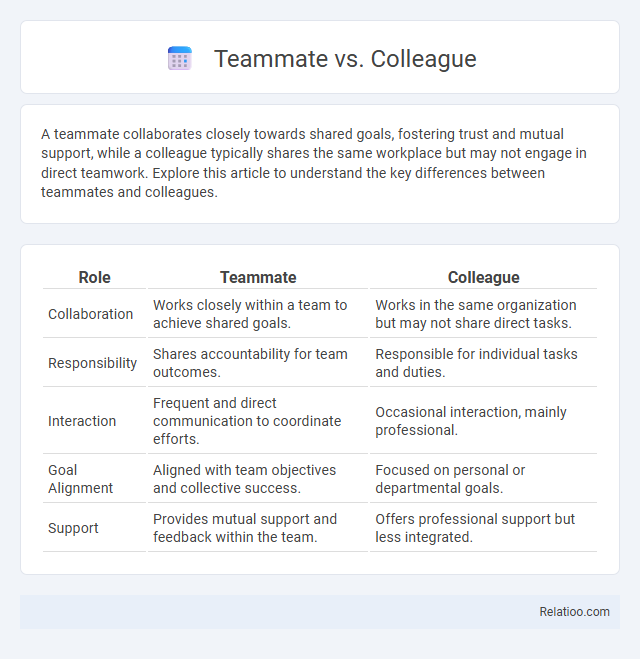A teammate collaborates closely towards shared goals, fostering trust and mutual support, while a colleague typically shares the same workplace but may not engage in direct teamwork. Explore this article to understand the key differences between teammates and colleagues.
Table of Comparison
| Role | Teammate | Colleague |
|---|---|---|
| Collaboration | Works closely within a team to achieve shared goals. | Works in the same organization but may not share direct tasks. |
| Responsibility | Shares accountability for team outcomes. | Responsible for individual tasks and duties. |
| Interaction | Frequent and direct communication to coordinate efforts. | Occasional interaction, mainly professional. |
| Goal Alignment | Aligned with team objectives and collective success. | Focused on personal or departmental goals. |
| Support | Provides mutual support and feedback within the team. | Offers professional support but less integrated. |
Defining Teammate and Colleague
A teammate is a member of the same team working collaboratively towards a shared goal, often in sports, projects, or workplace environments where coordination and mutual support are essential. A colleague refers to someone who works in the same organization or profession but may not necessarily collaborate closely or share specific team objectives. Understanding the distinction helps you navigate workplace relationships more effectively by recognizing when cooperation requires deeper engagement versus general professional association.
Key Differences Between Teammate and Colleague
Teammates actively collaborate toward common goals within the same project or team, often sharing responsibilities and supporting each other's tasks. Colleagues may work in the same organization but do not necessarily collaborate directly or share the same objectives, as their roles and departments can differ significantly. Your relationship with a teammate involves synchronized efforts and mutual reliance, whereas a colleague is simply a fellow employee without guaranteed cooperation.
Roles and Responsibilities in Teams
Teammates share specific roles and responsibilities within a unit, collaborating closely to achieve common goals and complete projects through coordinated efforts. Colleagues work within the same organization or field but may have distinct duties and less direct interaction, focusing on their individual tasks. Your effectiveness in contributing to team success depends on understanding these role distinctions and leveraging the unique strengths each member brings.
Collaboration Dynamics: Teammate vs Colleague
Teammates engage in direct collaboration with shared goals, responsibilities, and interdependent tasks within a cohesive unit, fostering closer communication and mutual support. Colleagues, while working in the same organization or field, may have more independent roles with less frequent interaction and collaboration. Understanding the distinction between teammates and colleagues enhances organizational dynamics by aligning teamwork strategies and communication practices effectively.
Communication Styles in the Workplace
Effective communication styles in the workplace vary significantly between teammates, colleagues, and coworkers, impacting collaboration and productivity. Teammates often engage in frequent, informal, and dynamic exchanges to coordinate tasks and solve problems efficiently, while colleagues typically maintain more formal and structured communication aligned with professional roles and broader organizational goals. Coworkers may rely on basic, task-oriented dialogue with less emphasis on collaboration, reflecting their shared but not necessarily interdependent responsibilities.
Impact on Workplace Relationships
Teammates foster collaboration through shared goals and interdependence, enhancing trust and communication in workplace relationships. Colleagues maintain professional respect and support but may work independently, resulting in less direct collaboration. The dynamic between teammates strengthens team cohesion and collective problem-solving, while relationships among colleagues emphasize mutual respect and individual expertise.
Trust and Reliability: Who Delivers More?
Trust and reliability differ significantly among teammates, colleagues, and partners based on the roles they play in professional settings. Teammates often demonstrate higher levels of trust and reliability as they work closely to achieve common goals, fostering accountability and cooperation. Colleagues maintain professional respect but may not share the same depth of commitment, while partners typically rely on mutual trust to execute long-term strategic initiatives effectively.
Contribution to Organizational Success
Teammates actively collaborate by sharing responsibilities, fostering innovation, and driving project-specific goals, which directly enhances organizational success. Colleagues contribute through their individual expertise and consistent performance within their roles, providing a stable foundation for operational efficiency. While team members engage in dynamic problem-solving, both teammates and colleagues collectively support the organization's mission through complementary contributions.
Choosing Between Teammate and Colleague in Projects
Choosing between teammate and colleague in projects hinges on the level of collaboration required; a teammate works closely with you toward shared goals, engaging in daily tasks and decision-making. A colleague might work in the same organization or field but without direct involvement in your specific project, offering broader support or expertise. Your project's success depends on identifying when to leverage the direct partnership of teammates versus the broader, sometimes indirect, contributions of colleagues.
Building Strong Professional Connections
Building strong professional connections involves understanding the subtle distinctions between teammate, colleague, and coworker; a teammate collaborates closely on shared goals within the same project or team, fostering trust and synergy. A colleague typically refers to any person working within the same organization or field, providing opportunities for networking and knowledge exchange beyond immediate teams. Coworkers, often used interchangeably with colleagues, emphasize shared workspace but may not always engage deeply, so prioritizing meaningful interactions among all three roles strengthens workplace relationships and career growth.

Infographic: Teammate vs Colleague
 relatioo.com
relatioo.com